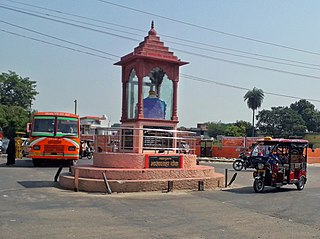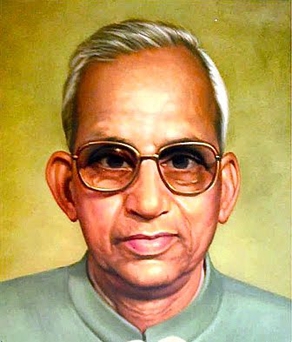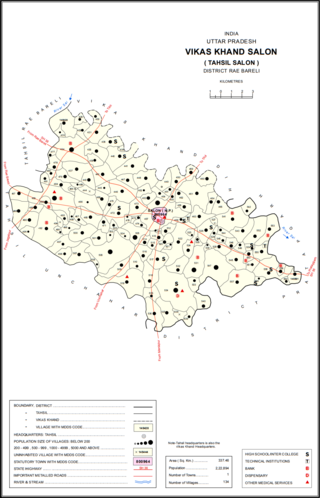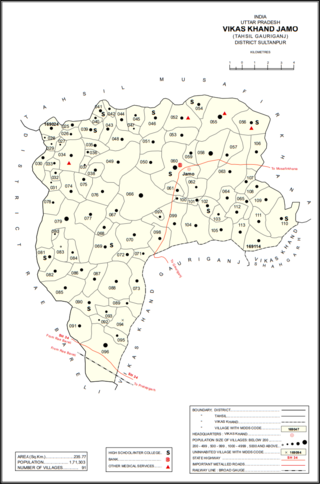History
The village had been founded by a Pashun family in the 18th century after they received a grant of land from the Nawab of Awadh who ruled from his capital in nearby Lucknow. So, the original landowners were Muslim. However, after they backed the losing side in the Indian War of Independence in 1857, the British rewarded an Ahir family whose men had assisted them by giving them a large part of the lands. The Muslim family continued to live in Guraura but with diminished property. By the 1960s, the two landowning groups were led by Shri Krishan Yadav, known as "Babu", and two young men, brothers, Zahir and Saghir Khan.
In the 1960s, Guraura's people were largely of the Ahir caste (roughly 50%), followed by Muslims (25%) and Dalits of several castes (25%), mainly either Pasi or Kori. The state government had started a junior basic school there and the Block Development Program at Sarojini Nagar along Kanpur Road had begun to have some influence there. Most of the male inhabitants worked in agriculture, but many had jobs in Lucknow city, in the Railways or other organizations. Farmers in Guraura grew sugar cane, wheat, or various kinds of daal (gram, lentils). They kept some cattle or buffalo for milk and for work. Only a few families had enough land to make a good living. Women worked at home or sometimes in the fields, but never outside the village.
The government Panchayati Raj system had taken root in the village, but the villagers preferred to elect a sarpanch, while adhering to their traditional leaders. These leaders were to form an alliance in the 1960s which would bring enormous changes in the 1970s and 1980s.

Jaunpur is a city and a municipal board in Jaunpur district in the Indian state of Uttar Pradesh. It is located 228 km southeast of state capital Lucknow. Demographically, Jaunpur resembles the rest of the Purvanchal area in which it is located.

Budaun is a medieval city and headquarters of Budaun district, in the Indian state of Uttar Pradesh. It is located about a mile east of the Sot river, and 27 km north of the Ganges, in the Rohilkhand region of Uttar Pradesh. According to the 2011 census, it has a population of 159,221, which is projected at 161,555 at present. Budaun rose to historical importance as the capital of the Delhi Sultanate for four years from 1210 CE to 1214 CE during the reign of Sultan Iltutmish. It was the most important post of Northern Frontier during Mughal reign. Budaun is a big market, historically famous and religiously important city. Budaun is 230 km south-east of New Delhi and 245 km north-west of Lucknow, both taking about 6 hours by road.

Bulandshahr, formerly Baran, is a city and a municipal board in Bulandshahr district in the state of Uttar Pradesh, India.

Ramswaroop Verma was an Indian humanist. He was the founder of Arjak Sangh, a humanist organisation. The organisation emphasises social equality and is strongly opposed to Brahminism. Verma denied the existence of god and soul. He was strongly opposed to the doctrine of Karma and Fatalism. Verma campaigned tirelessly against Brahminism and Untouchability. According to him, Brahminism is rooted in the doctrine of rebirth and it is not possible to eradicate it without attacking the doctrine of rebirth. Verma strongly asserts that Brahminism cannot be reformed, and it has to be negated totally.
Kushwaha is a community of the Indo-Gangetic Plain that has traditionally been involved in agriculture, including beekeeping. The term has been used to represent different sub-castes of the Kachhis, Kachhvahas, Koeris and Muraos. Under the Indian governments system of positive discrimination, the Kushwahas are classified as a "Backward" or Other backward class. The Kushwaha had worshipped Shiva and Shakta, but beginning in the 20th century, they claim descent from the Suryavansh (Solar) dynasty via Kusha, one of the twin sons of Rama and Sita. At present, it is a broad community formed by coming together of several caste groups with similar occupational backgrounds and socio-economic status, who, over the time, started inter-marrying among themselves and created all India caste network for caste solidarity. The communities which merged into this caste cluster includes Kachhi, Kachhwaha, Kushwaha, Mali, Marrar, Saini, Sonkar, Murai, Shakya, Maurya, Koeri and Panara.
Yadav, Jadam, or Jadav refers to a grouping of traditionally non-elite, peasant-pastoral communities or castes in India that since the 19th and 20th centuries have claimed descent from the legendary king Yadu as a part of a movement of social and political resurgence. The term Yadav now covers many traditional peasant-pastoral castes such as Ahirs of the Hindi belt and the Gavli of Maharashtra.
The Qidwai or Kidwai are a community of Muslims in South Asia. They are mostly settled in the state of Uttar Pradesh in India. They are also settled in the city of Karachi, Sindh, Pakistan, and also in areas of the Middle East specifically, Saudi Arabia, Palestine and Qatar. The Qidwai, together with the Milki, Malik and Chaudhary form a community of substantial landowners.

Islam in Uttar Pradesh is the second largest religion in the state with 38,483,967 adherents in 2011, forming 19.70% of the total population. Muslims of Uttar Pradesh have also been referred to as Hindustani Musalman. They do not form a unified ethnic community, but are differentiated by sectarian and Baradari divisions, as well as by language and geography. Nevertheless, the community shares some unifying cultural factors. Uttar Pradesh has more Muslims than any Muslim-majority country in the world except Indonesia, Pakistan, Bangladesh, Nigeria, Egypt, Iran, Turkey, Iraq and Afghanistan.
Salindh is a small village which borders the town of Safipur in the Unnao district of the Indian state of Uttar Pradesh.

Western Uttar Pradesh is a region in India that comprises the western districts of Uttar Pradesh state, including the areas of Rohilkhand and those where Hindi and Braj are spoken. The region has some demographic, economic and cultural patterns that are distinct from other parts of Uttar Pradesh, and more closely resemble those of Haryana and Rajasthan states. The largest city of the region is Ghaziabad, while the second-largest city, Agra, is a major tourist destination.
Juggaur or Jugor is a village in Chinhat block, Lucknow district, Uttar Pradesh, India. As of the 2011 Census of India, the population of the village is 9,478, in 1,590 households. The village code is 0297. It is part of Lucknow tehsil. It is the seat of a gram panchayat.

Khasaura is a large village in Harpalpur block of Hardoi district, Uttar Pradesh, India. It lies on the left bank of the Ramganga river, to the north of the road connecting Hardoi and Sandi with Farrukhabad. The village hosts a large market twice per week, on Wednesdays and Sundays. It deals mainly in vegetables.

Khiron is a village and corresponding community development block in Rae Bareli district, Uttar Pradesh, India. Located on the main Raebareli-Unnao road,semari Khiron is an old Muslim town that historically served as the seat of a pargana. As of 2011, the village has a population of 9,955, in 1,714 households. It has six primary schools and one medical clinic. It serves as the headquarters of a nyaya panchayat that also includes 11 other villages.

Bela Bhela, also called Uttarpara, is a village in Rahi block of Rae Bareli district, Uttar Pradesh, India. It is located 9 km from Rae Bareli, the district headquarters, east of the road to Dalmau. It lies in a belt of stiff clay soil which is highly productive agriculturally and is interspersed with wetlands and patches of barren usar soil. Bela Bhela is a large village consisting of many hamlets. As of 2011, Bela Bhela has a total population of 16,623 people, in 3,004 households. It has one primary school and one medical clinic.

Nain is a village in Salon block of Rae Bareli district, Uttar Pradesh, India. It is located on the south bank of the Sai river, north of the main road from Salon to Raebareli. As of 2011, the village has a population of 2,028 people, in 372 households. It has one primary school and no healthcare facilities.

Mau is a large village in Dih block of Rae Bareli district, Uttar Pradesh, India. It is located on the road from Fursatganj to the Gukana ghat on the Ganges, 4 miles west of Nasirabad and 8 miles from Jais. A road branches off at Mau and connects to Nasirabad. To the northwest of the village is a large lake called the Bara Tal.

Rokha is a large village in Dih block of Rae Bareli district, Uttar Pradesh, India. Historically the namesake of a pargana, Rokha is a predominantly agricultural village consisting of many hamlets. It is located 28 km from Raebareli, the district headquarters. The large village of Mau also borders Rokha to the north. Rokha is connected by road with Nasirabad and Jais to the northeast and Suchi to the southwest.

Gaura is a village in Jamo block of Amethi district, Uttar Pradesh, India. The namesake of the historical pargana of Gaura Jamun, Gaura consists of a main site called Gaura khas in the northeast surrounded by several smaller hamlets. The village lands are fertile and contain many orchard groves. In the east-central part there is a large jhil which provides a convenient source of irrigation but also sometimes overflows and floods the surrounding fields. Gaura is located just north of Jamo on the Gauriganj-Jagdishpur road, and another road also leads off to Musafirkhana.
Chaukhara is a town and Nagar panchayat in Domariaganj tehsil of Siddharthnagar district in the state of Uttar Pradesh, India.
Dehuli, also spelled Dihuli, is a village in Jasrana block of Firozabad district, Uttar Pradesh, India. It is known for a 1981 incident of caste-based violence where a group of upper-caste gunmen killed 24 people, mainly from the Jatav caste. As of 2011, Dehuli had a population of 3,683, in 593 households.











